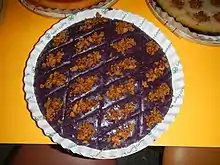Ube halaya
Ube halaya or halayang ube (variant spellings halea, haleya; from the Spanish jalea, "jam") is a Philippine dessert made from boiled and mashed purple yam (Dioscorea alata, locally known as ube).[1] Ube halaya is the main base in ube/purple yam flavored-pastries and ice cream. It can also be incorporated in other desserts such as halo-halo. It is also commonly anglicized as ube jam, or called by its original native name, nilupak na ube.
_01.jpg.webp)  Top: ube halaya is distinctively naturally purple Bottom: ube halaya topped with latík | |
| Alternative names | Ube jam, Halayang ube, Purple yam jam |
|---|---|
| Course | dessert |
| Place of origin | Philippines |
| Serving temperature | cold |
| Main ingredients | Mashed purple yam, coconut milk and/or condensed milk, and butter |
History
The Philippines show to have one of the highest phenotype variability of Ube.[2] Identified remains of Dioscorea alata at Ille Cave of Palawan (c. 11,000 BP) is evidence of the exploitation of the said breed of purple yam.[3]In a Tagalog and Spanish dictionary that was published during 1613, it recorded therein the word Ube, further indicating usage of the crop by Filipinos during the arrival of the Spanish. The second earliest Philippine cookbook to come out was in 1918 which details jam-making. Filipino food historian' Felice Prudente Sta. Maria theorized that this may also have been done in making Ube halaya, through the Nilupak process. [4]
Preparation
The main ingredient is peeled and boiled purple yam which is grated and mashed. The mashed yam, with condensed milk (originally sweetened coconut milk), are added to a saucepan where butter or margarine had been melted. The mixture is stirred until thickened. Once thickened, the mixture is cooled down and placed on a platter or into containers of various shapes.
Ube halaya is typically served cold, after refrigeration. Optional topping includes browned grated coconut, latik, or condensed milk.
Variations
Ube halaya is a type of nilupak (mashed/pounded starchy food with coconut milk and sugar) which has several variants that use other types of starchy root crops or fruits. Generally, the term halaya is reserved for nilupak made with ube, while nilupak is more commonly used for variants made with mashed cassava or saba bananas. Variants made from sweet potato and taro can be known as either halaya or nilupak.
Ube macapuno
Ube halaya served with macapuno (coconut sport) is a notable combination known as ube macapuno. The combination is also used in other ube recipes, like in ube cakes and ube ice cream.[5][6]
Camote halaya
Camote halaya, sometimes known as "camote delight" or "sweet potato jam", is a variant that uses mashed sweet potato (camote) instead of ube. It is prepared identically to ube halaya. It has a light yellow color.[7][8] It is traditionally known as nilupak na kamote, especially when served on banana leaves.[9]
Halayang kalabasa
Halayang kalabasa, also known as "squash halaya" or "pumpkin jam", is a variant that uses mashed calabaza (kalabasa). It is prepared identically to ube halaya. It is typically orange to light brown in color.[10][11]
Binagol
Binagol is a unique version from the Eastern Visayas which use mashed taro corms. It is distinctively sold in halved coconut shells. It can range in color from creamy white to brown.[12]
References
- "Halayang Ube-Purple Yam Jam".
- Cruz, V.M.V.; Altoveros, N.C.; Mendioro, M.S.; Ramirez, D.A. (1999). "Geographical patterns of diversity in the Philippine edible yam collection". Plant Genetic Resources Newsletter. 119: 7–11.
- Balbaligo, Yvette (15 November 2007). "A Brief Note on the 2007 Excavation at Ille Cave, Palawan, the Philippines". Papers from the Institute of Archaeology. 18 (2007): 161. doi:10.5334/pia.308.
- https://theculturetrip.com/asia/philippines/articles/ube-the-philippine-purple-yam-more-popular-than-vanilla/
- Belen, Jun. "Ube, the Purple Yam: Why Filipinos Love Purple Sweet Treats". Junblog. Retrieved 27 March 2019.
- Veneracion, Connie. "Ube – macapuno dessert". Casa Veneracion. Retrieved 27 March 2019.
- "Kamote Halaya Recipe (Sweet Potato Dessert)". Petite Rosie. Retrieved 7 June 2019.
- "How to cook the famous Camote Delight Dessert". PinoyRecipe.net. Retrieved 7 June 2019.
- "Nilupak Recipe". Pinoy Recipe At Iba Pa. Retrieved 23 April 2019.
- "Halayang Kalabasa ( Pumpkin Jam)". Tagalog Kitchen. Retrieved 7 June 2019.
- "Halayang Kalabasa". Pinoy Hapagkainan. Retrieved 7 June 2019.
- "Leyte Pasalubong". Our Awesome Planet. Retrieved 9 April 2019.
- "NILUPAK na UBE at GABI". Tagalog Kitchen. Retrieved 23 April 2019.
- Alejandro, R., & Tettoni, L. (2012). Authentic Recipes from the Philippines. New York: Tuttle Pub.
